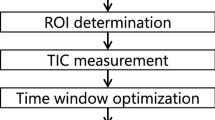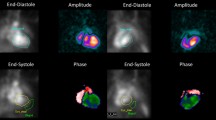Abstract
This study describes a non-invasive method for assessment of the lung transit time distribution of a tracer, using first-pass technetium-99m albumin angiocardiography and a model-free method of deconvolution. Ten patients received a first injection of 1 MBq kg−1 in the external jugular vein to position a gamma camera in the left anterior oblique position and two additional injections (5 MBq kg−1 to record first-pass angiocardiographic data. Right and left ventricular time-activity curves were derived from regions of interest every 0.5 s over a 1-min period. The left ventricular curve was deconvoluted by the right ventricular curve to obtain the lung transport function. The deconvolution procedure was based on a modified version of the Kalman filtering technique. The procedure was repeated at an interval of 30 min in eight patients. Two patients were re-examined up to 2 years later. Skewness, kurtosis and relative dispersion of the distributions did not change over time. We also found that the distribution, once normalized by its first moment, was independent of isolated changes in heart rate or cardiac output. Comparison of curve shapes at an interval of 30 min by point by point analysis demonstrated the reproducibility of the technique. We conclude that computation of the pulmonary transit time distribution of99mTc-albumin from a standard angiocardiography procedure by model-free deconvolution is reliable and reproducible over time. We suggest that it may be a valuable toot for the non-invasive follow-up of the pulmonary circulation.
Similar content being viewed by others
References
Bassingthwaighte JB. Circulatory transport and the convolution integral.Mayo Clin Proc 1967; 42: 137–154.
Knopp TJ, Bassinghwaighte JB. Effect of flow on transpulmonary circulatory transport functions.J Appl Physiol 1969; 27: 36–43.
Zierler KL. Theoretical basis of indicator-dilution methods for measuring flow and volume.Circ Res 1962; 10: 393–407.
Ayappa I, Brown LV, Wang PM, Lai-Fook SJ. Arterial, capillary, and venous transit times and dispersion measured in isolated rabbit lungs.JAppl Physiol 1995; 79: 261–269.
Presson RG, Hanger CC Jr, Godbey PS, Graham JA, Lloyd TC Jr, Wagner WW Jr. Effect of increasing flow on distribution of pulmonary capillary transit times.J Appl Physiol 1994; 76: 1701–1711.
Lewis ML, de Caterina R, Giuntini C. Distribution function of transit times in the human pulmonary circulation.J Appl Physiol 1994; 76: 1363–1371.
Hogg JC, McLean T, Martin BA, Wiggs B. Erythrocyte transit and neutrophil concentration in the dog lung.J Appl Physiol 1988; 65: 1217–1225.
Maseri A, Caldini P, Permutt S, Zierler KL. Frequency function of transit times through dog pulmonary circulation.Circ Res 1970; 26: 527–543.
MacNee W, Martin BA, Wiggs BR, Belzberg AS, Hogg JC. Regional pulmonary transit times in humans.J Appl Physiol 1989; 66: 844–850.
Larson KB, Snyder DL. Measurement of relative blood flow, transit-time distributions and transport-model parameters by residue detection when radiotracer recirculates.J Theor Biol 1972; 37: 503–529.
Clough AV, Al-Tinawi A, Linehan JH, Dawson CA. Regional transit time estimation from image residue curves.Ann Biomed Eng 1994; 22: 128–143.
Coulam CM, Warner HR, Wood EH, Bassingthwaighte JB. A transfer function analysis of coronary and renal circulation calculated from upstream and downstream indicator-dilution curves.Circ Res 1966; 19: 879–890.
Bassinghwaighte JB, Ackerman FH, Wood EH. Applications of the lagged normal density curve as a model for arterial dilution curves.Circ Res 1966; 18: 398–415.
Bock JC. Validity of the lagged normal density function as a model for pulmonary indicator dispersion.Biomed Instrum Technol 1990; 24: 42–49.
Clough AV, Cui D, Linehan JH, Krenz GS, Dawson CA, Maron MB. Model-free numerical deconvolution of recirculating indicator concentration curves.J Appl Physiol 1993; 74: 1444–1453.
Gamel J, Rousseau WF, Katholi CR, Mesel E. Pitfalls in digital computation of the impulse response of vascular beds from indicator-dilution curves.Circ Res 1973; 32: 516–523.
Commenges D, Brendel AJ. A deconvolution program for processing radiotracer dilution curves.Comput Prog Biomed 1982; 14: 271–276.
Adams R, Hine GJ, Zimmerman CD. Deadtime measurements in scintillation cameras under scatter conditions simulating quantitative nuclear cardiography.J Nucl Med 1978; 19: 538–544.
Kalman RE. A new approach to linear filtering and prediction problems.Trans ASME J Basic Eng 1960; March: 35–45.
Phillips DL. A technique for the numerical solution of certain equations of the first kind.J Assoc Comput Machin 1962; 9: 97–101.
Fouad-Tarazi FM, MacIntyre WJ. Radionuclide methods for cardiac output determination.Eur Heart J 1990; 11: 33–40.
Feldschuh J, Enson Y. Prediction of the normal blood volume: relation of blood volume to body habitus.Circulation 1977; 56: 605–612.
Snedecor GW, Cochran WG. Statistical methods, 6th edn. Ames: The Iowa State University Press, 1967.
Donato L. Basic concepts of radiocardiography.Semin Nucl Med 1973; 3: 111–130.
Knopp TJ, Dobbs WA, Greenleaf JF, Bassingthwaighte JB. Transcoronary intravascular transport functions obtained via a stable deconvolution technique.Ann Biomed Eng 1976; 4: 44–59.
Glass EC, Rahimian J, Hines HH. Effect of region of interest selection on first-pass radionuclide cardiac output determination.J Nucl Med 1986; 27: 1282–1292.
Neufeld GR. Computation of transit time distributions using sampled data Laplace transforms.J Appl Physiol 1971, 31: 148–153.
Bronikowski TA, Dawson CA, Linehan JH. Model-free deconvolution techniques for estimating vascular transport function.Int J Biomed Comput 1983; 14: 411–429.
Wenting GJ, Brouwer RML, Manin't Veld AJ, Schalekamp MADH. First passage radionuclide cardiography for determination of cardiac output: a critical analysis.Eur Heart J 1990; 11: 41–48.
Beck JV, Arnold KJ. Parameter estimation in engineering and science. London: Wiley, 1977.
Crump ND. A Kalman filter approach to the deconvolution of seismic signals.Geophysics 1974; 39: 1–13.
Author information
Authors and Affiliations
Rights and permissions
About this article
Cite this article
Capderou, A., Douguet, D., Similowski, T. et al. Non-invasive assessment of technetium-99m albumin transit time distribution in the pulmonary circulation by first-pass angiocardiography. Eur J Nucl Med 24, 745–753 (1997). https://doi.org/10.1007/BF00879662
Received:
Revised:
Issue Date:
DOI: https://doi.org/10.1007/BF00879662




